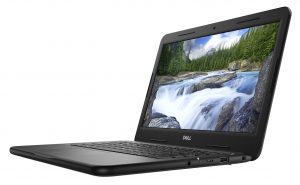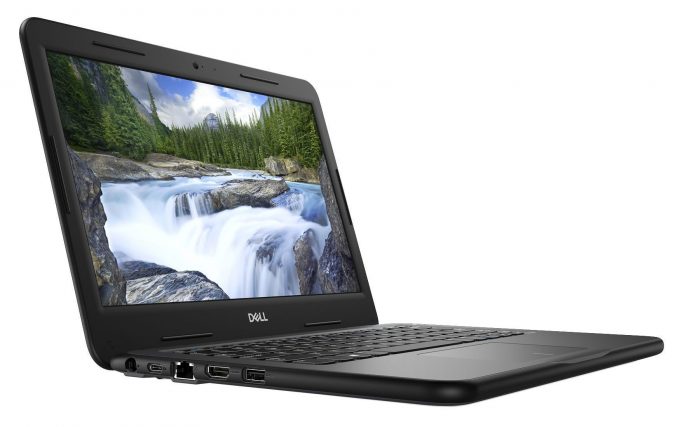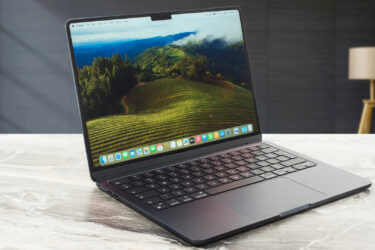Dell Latitude 3300 review – a 13-inch tank for students and small business
 Latitude 3300 sits on the bottom end of the Latitude family by Dell. This time, it is not aimed at high-profile businesses and people that need their laptop entirely for work. However, it can be more appealing to students who are in for something durable, that is going to last them throughout the entire day at school, and still has some juice left for entertainment.
Latitude 3300 sits on the bottom end of the Latitude family by Dell. This time, it is not aimed at high-profile businesses and people that need their laptop entirely for work. However, it can be more appealing to students who are in for something durable, that is going to last them throughout the entire day at school, and still has some juice left for entertainment.
This is why, Dell has opted for the yester-year processors, ranging from the Pentium 4415U all the way up to the Core i5-8250U. Additionally, you have the choice of a 768p TN panel and a Full HD IPS display. Despite, aimed at students, this laptop is not one of the cheapest on the market. What then is going to make them buy it? Let’s find out.
You can check the prices and configurations in our Specs System: https://laptopmedia.com/series/dell-latitude-13-3300/
Contents
Specs Sheet
- HDD/SSD
- up to 256GB SSD
- RAM
- up to 8GB
- OS
- Windows 10 Home, Windows 10 Pro, Windows OS
- Battery
- 42Wh, 3-cell, 56Wh
- Dimensions
- 329 x 230 x 22 mm (12.95" x 9.06" x 0.87")
- Weight
- 1.56 kg (3.4 lbs)
- Ports and connectivity
- 2x USB Type-A
- 3.2 Gen 1 (5 Gbps)
- 1x USB Type-C
- 3.2 Gen 1 (5 Gbps), DisplayPort
- HDMI
- 1.4a
- Card reader
- SD, SDHC, SDXC
- Ethernet LAN
- 10, 100, 1000
- Wi-Fi
- 802.11ac
- Bluetooth
- 4.2
- Audio jack
- 3.5 mm combo
- Features
- Fingerprint reader
- Web camera
- HD (720p@30FPS)
- Backlit keyboard
- Microphone
- Speakers
- 2x 2W Speakers
- Optical drive
- Security Lock slot
All Dell Latitude 13 3300 configurations
What’s in the box?
Its packaging includes the laptop itself, as well as a 65Wh charging brick and the mandatory manuals and guides.
Design and construction
Let’s begin by saying that the laptop is entirely made out of plastic. However, this doesn’t stop it to be built like a tank! No, seriously, the Latitude 3300 looks like it can take a lot of beating, and Dell is confident enough that they stated that on their own website. They also say something about surviving a 30″ drop onto a steel surface, however, we cannot entirely believe such in-house tests. Moreover, they say that their warranty doesn’t cover accidental damages and if you want one, you need to buy it.
This is completely normal, though. What is not very normal these days is to see a 13-inch laptop that is 22mm thick and has a starting weight of 1.59 kg.
It also has a rubberized material going all the way around the sides of the laptop. They spread evenly onto the lid, which by the way, cannot be opened with a single hand.
If we move on to the base of the notebook, it has a spill-resistant keyboard that lacks a backlight has a rather short travel, but on the bright side, the feedback is clicky and provides a decent typing experience.
On the bottom plate, you can see the ventilation grills, as well as the speaker cut-outs and one more ventilation grill that helps the thermal management of the M.2 SSD.
Ports
On the left side of the laptop you’re going to find the barrel-style charging plug, a USB Type-C 3.1 (Gen. 1), an RJ-45 connector, followed by an HDMI port and a USB Type-A 3.1 (Gen. 1) port. On the other side, there is another USB Type-A 3.1 (Gen. 1) port a MicroSD card slot and an audio combo jack.
Disassembly and upgrade options
This laptop has exactly 10 Phillips head screws that hold the bottom plate in place. Unfortunately, you have to remove it in order to upgrade your device, however, on the bright side, it is extremely easy to do so. Just unscrew them (they will stay attached to the panel, so don’t worry) and then pop the plate up with a plastic pry tool.
As far as the cooling is concerned, Dell doesn’t really use the most sophisticated design. It only features a single – super-thin heat pipe. Additionally, the fan is one of the smallest we’ve seen – only larger than the two found on the XPS 13 9380 and the Lenovo Ideapad S940.
Despite the budget nature of the device, it still has upgradeable RAM and storage, even though they comprise only one RAM DIMM and only one storage option in the form of an M.2 PCIe slot.
Lastly, there is the battery, which has a pretty substantial capacity – 56Wh. It should provide a great battery life, given the size and the low resolution of the screen.
Display quality
Dell Latitude 3300 is equipped with an HS TN panel, AUO 2C7YD-B133XTN (AUO162C). Its diagonal is 13.3-inch (33.78 cm), and the resolution – 1366 x 768p. Additionally, the screen ratio is 16:9, the pixel density – 118 ppi, their pitch – 0.22 х 0.22 mm. The screen can be considered Retina when viewed from at least 75 cm (from this distance, the average human eye can’t see the individual pixels).

Expectedly, the viewing angles are terrible. We offer images at different angles to evaluate the quality.

The maximum measured brightness is 248 nits (cd/m2) in the middle of the screen and 232 nits (cd/m2) average across the surface with a maximum deviation of 9%. The Correlated Color Temperature on a white screen and at maximum brightness is 7920K – colder (bluer) than the 6500K temperature for sRGB. The average color temperature through the grey scale before profiling is 20000K – something our profiles fix.
In the illustration below you can see how the display performs from uniformity perspective. The illustration below shows how matters are for operational brightness levels (approximately 140 nits) – in this particular case at 54% Brightness (White level = 140 cd/m2, Black level =0.44 cd/m2).
Values of dE2000 over 4.0 should not occur, and this parameter is one of the first you should check if you intend to use the laptop for color-sensitive work (a maximum tolerance of 2.0 ). The contrast ratio is poor – 320:1.

To make sure we are on the same page, we would like to give you a little introduction of the sRGB color gamut and the Adobe RGB. To start, there’s the CIE 1976 Uniform Chromaticity Diagram that represents the visible specter of colors by the human eye, giving you a better perception of the color gamut coverage and the color accuracy.
Inside the black triangle, you will see the standard color gamut (sRGB) that is being used by millions of people in HDTV and on the web. As for the Adobe RGB, this is used in professional cameras, monitors, etc for printing. Basically, colors inside the black triangle are used by everyone and this is the essential part of the color quality and color accuracy of a mainstream notebook.
Still, we’ve included other color spaces like the famous DCI-P3 standard used by movie studios, as well as the digital UHD Rec.2020 standard. Rec.2020, however, is still a thing of the future and it’s difficult for today’s displays to cover that well. We’ve also included the so-called Michael Pointer gamut, or Pointer’s gamut, which represents the colors that naturally occur around us every day.
The yellow dotted line shows Dell Latitude 3300’s color gamut coverage.
Its display covers 50% of the sRGB/ITU-R BT.709 (web/HDTV standard) in CIE1976.

Our “Design and Gaming” profile delivers optimal color temperature (6500K) at 140 cd/m2 luminance and sRGB gamma mode.
We tested the accuracy of the display with 24 commonly used colors like light and dark human skin, blue sky, green grass, orange, etc. You can check out the results at factory condition and also, with the “Design and Gaming” profile.
Below you can compare the scores of Dell Latitude 3300 with the default settings (left), and with the “Gaming and Web design” profile (right).


The next figure shows how well the display is able to reproduce really dark parts of an image, which is essential when watching movies or playing games in low ambient light.
The left side of the image represents the display with stock settings, while the right one is with the “Gaming and Web Design” profile activated. On the horizontal axis, you will find the grayscale and on the vertical axis – the luminance of the display. On the two graphs below you can easily check for yourself how your display handles the darkest nuances but keep in mind that this also depends on the settings of your current display, the calibration, the viewing angle, and the surrounding light conditions.

Response time (Gaming capabilities)
We test the reaction time of the pixels with the usual “black-to-white” and “white-to-black” method from 10% to 90% and vice versa.
We recorded Fall Time + Rise Time = 11 ms.

Health impact – PWM / Blue Light
PWM (Screen flickering)
Pulse-width modulation (PWM) is an easy way to control monitor brightness. When you lower the brightness, the light intensity of the backlight is not lowered, but instead turned off and on by the electronics with a frequency indistinguishable to the human eye. In these light impulses, the light/no-light time ratio varies, while brightness remains unchanged, which is harmful to your eyes. You can read more about that in our dedicated article on PWM.
Dell Latitude 3300’s display doesn’t use PWM to adjust its brightness at any point. This makes it comfortable (in this aspect) for long periods of use, without straining your eyes excessively.

Blue light emissions
Installing our Health-Guard profile not only eliminates PWM but also reduces the harmful Blue Light emissions while keeping the colors of the screen perceptually accurate. If you’re not familiar with the Blue light, the TL;DR version is – emissions that negatively affect your eyes, skin and your whole body. You can find more information about that in our dedicated article on Blue Light.
Conclusion
Dell Latitude 3300’s display in our configuration features a TN panel, that has fast response times and doesn’t use PWM to adjust its brightness levels. However, it has a low resolution, poor contrast ratio, uncomfortable viewing angles and is able to display only half of the colors on the Internet.
Buy our profiles
Since our profiles are tailored for each individual display model, this article and its respective profile package are meant for Dell Latitude 3300 configurations with 13.3″ AUO 2C7YD-B133XTN (AUO162c) (FHD, 1366 x 768) TN panel.
*Should you have problems with downloading the purchased file, try using a different browser to open the link you’ll receive via e-mail. If the download target is a .php file instead of an archive, change the file extension to .zip or contact us at [email protected].
Read more about the profiles HERE.
In addition to receiving efficient and health-friendly profiles, by buying LaptopMedia's products you also support the development of our labs, where we test devices in order to produce the most objective reviews possible.

Office Work
Office Work should be used mostly by users who spend most of the time looking at pieces of text, tables or just surfing. This profile aims to deliver better distinctness and clarity by keeping a flat gamma curve (2.20), native color temperature and perceptually accurate colors.

Design and Gaming
This profile is aimed at designers who work with colors professionally, and for games and movies as well. Design and Gaming takes display panels to their limits, making them as accurate as possible in the sRGB IEC61966-2-1 standard for Web and HDTV, at white point D65.

Health-Guard
Health-Guard eliminates the harmful Pulse-Width Modulation (PWM) and reduces the negative Blue Light which affects our eyes and body. Since it’s custom tailored for every panel, it manages to keep the colors perceptually accurate. Health-Guard simulates paper so the pressure on the eyes is greatly reduced.
Get all 3 profiles with 33% discount
Sound
Dell Latitude 3300 has a relatively good sound quality. Although the speakers are not very loud, the tones are clear throughout the entire frequency range.

Drivers
All of the drivers and utilities for the Latitude 3300 can be downloaded from here: https://www.dell.com/support/home/us/en/04/product-support/product/latitude-13-3300-laptop/drivers
Battery
Now, we conduct the battery tests with Windows Better performance setting turned on, screen brightness adjusted to 120 nits and all other programs turned off except for the one we are testing the notebook with. Latitude 3300 in our configuration came with a 56Wh battery pack.
Combining the relatively high battery capacity and the 13-inch 768p display results in a very respectable battery life figures. We were able to get around 15 hours of web browsing and a little over 13 hours of video playback.
In order to simulate real-life conditions, we used our own script for automatic web browsing through over 70 websites.


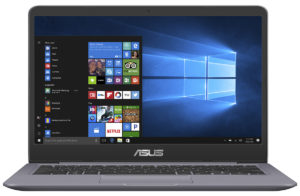

For every test like this, we use the same video in HD.




CPU options
Dell Latitude 3300 comes with one of the following – Pentium 4415U, Celeron 3865U, Core i3-7020U, and the most powerful of the bunch – the Core i5-8250.
Results are from the Cinebench 20 CPU test (the higher the score, the better)
Results are from our Photoshop benchmark test (the lower the score, the better)
Results are from the Fritz chess benchmark (the higher the score, the better)
GPU options
There is no choice of a dedicated graphics card here. Depending on the processor you buy the laptop with, you’re going to get the HD Graphics 610, 620 or the UHD 620.
Results are from the 3DMark: Fire Strike (Graphics) benchmark (higher the score, the better)
Results are from the Unigine Superposition benchmark (higher the score, the better)
Temperatures and comfort
Max CPU load
In this test we use 100% on the CPU cores, monitoring their frequencies and chip temperature. The first column shows a computer’s reaction to a short load (2-10 seconds), the second column simulates a serious task (between 15 and 30 seconds), and the third column is a good indicator of how good the laptop is for long loads such as video rendering.
Average core frequency (base frequency + X); CPU temp.
| Intel Core i5 8250U (15W TDP) | 0:02 – 0:10 sec | 0:15 – 0:30 sec | 10:00 – 15:00 min |
|---|---|---|---|
| Dell Latitude 3300 | 3.13 GHz (B+96%) @ 95°C | 2.54 GHz (B+59%) @ 96°C | N/A |
| Lenovo IdeaPad 330s-14 | 2.32 GHz (B+31%) @ 57°C | 1.72 GHz (B+7%) @ 56°C | 1.68 GHz (B+5%) @ 57°C |
| Xiaomi Notebook Air 13 | 2.84 GHz (B+78%) @ 80°C | 2.16 GHz (B+35%) @ 71°C | 2.03 GHz (B+28%) @ 76°C |
Dell Latitude 3300 started the test is a great way – 3.13 GHz, which is significantly higher than the opponents we put it against. However, the temperatures were also a lot higher. After the second checkpoint, we saw a significant decrease, although still better than the opposition. However, temperatures refused to go down – 96C after the second measurement. By the way, we should mention that the fan turns on after about 20 seconds into the torture. What we didn’t expect, though, was that the laptop won’t be able to finish our 15-minute Prime95 stress. The laptop simply shut down after 8 minutes of 100% CPU load. Honestly, we weren’t expecting that the Core i5-8250U is going to be a very capable CPU for video rendering, but we were certainly not prepared that it is not going to pass the test whatsoever.
Just before it shut down, the clock speed was 2.14 GHz, while the temperature was 86C. If someone has this device and has encountered such a problem and had it resolved, make sure you leave a comment, because the device we tested was not an engineering sample but an actual retail unit from the store.
Comfort during full load
Obviously, we weren’t able to run the stress test for the full 15 minutes, but after 8, the laptop was a little warm on the outside – around 44C.
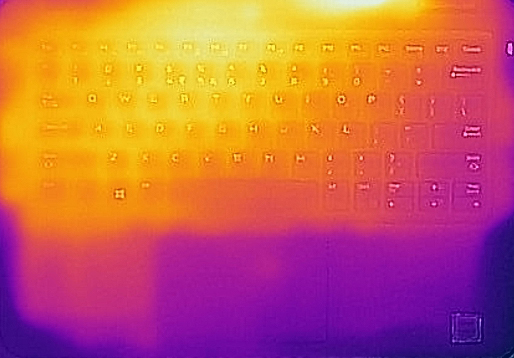

Verdict
Dell Latitude 3300 started off as a very good option for students. It is incredibly sturdy and has a rubberized sturdy edge all around it. However, it is a little pricey, and we are frankly wondering why is it marketed towards students. I mean, most of us have been students and prioritizing your expenses will never put that amount of money for a laptop. Or… a laptop like this one, more specifically.
For the same amount of money, you can get a budget gaming laptop or if you don’t a laptop for games you can opt for an Ideapad or even some Inspiron devices. Yes, they won’t be that sturdy and their battery will probably last less time. This makes us think that the Latitude 3300 will be more suitable for a working environment, where there is a chance to drop your laptop at any given time.
In terms of the I/O and its input devices, the notebook is not bad at all. Basically, you can’t ask for more and despite the keyboard lacks a backlight and its key travel is pretty short it is really pleasant to type on. Additionally, the laptop is more than easy to upgrade, and you get a single RAM DIMM and an NVMe- enabled M.2 slot.
As we tested the laptop in a configuration with a 768p TN panel we figured out that this type of displays is obsolete. In a world where almost every budget notebook has an IPS 1080p display alternative, we would always recommend spending the extra bucks for such a screen. Nevertheless, the panel (AUO 2C7YD-B133XTN (AUO162C)) used on this device has the advantages of a very fast response rate and lack of PWM for brightness adjustment, however, they are heavily overweighted by the poor contrast ratio, terrible viewing angles, and modest color coverage.
Sadly, we have to tell you that the Latitude 3300 probably is not the best purchase as of the moment of writing this review. We noticed that it has a problem sustaining high load during longer periods of time. More specifically, we have never had problems with a laptop during our full load tests. Well, before we had this device with us. After 8 minutes of torture, the Latitude 3300 just randomly shuts down. We tried a couple of times and at some point, it shut down only 5 minutes into the test. Probably Dell can address this issue in some of the future updates but it is frustrating to have such a problem with a brand new laptop.
Pros
- Very rigid and durable design
- The keyboard is pleasant for typing
- Exceptional battery life
- Easy to upgrade and features an M.2 PCIe SSD and one RAM DIMM slot
- Its display doesn’t use PWM to adjust its brightness levels (AUO 2C7YD-B133XTN (AUO162C))
Cons
- Gets hot under heavy load
- Shuts down by itself after some time of full load (less than 10 minutes)
- Keyboard lacks backlight
- Pricey for a student notebook
- 768p TN panel is a questionable choice due to the low cover coverage, poor contrast ratio and uncomfortable viewing angles (AUO 2C7YD-B133XTN (AUO162C))
You can check the prices and configurations in our Specs System: https://laptopmedia.com/series/dell-latitude-13-3300/

